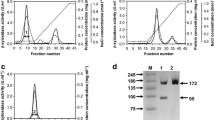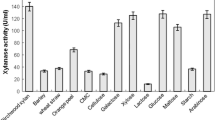Abstract
During the bleaching of wood pulp for the paper industry, large amounts of chlorinated aromatic compounds are produced and released into the environment. These compounds are extremely toxic and are a major source of pollution. The paper and pulp industry is seeking for alternative methods for bleaching pulp. One such method involves the use of hemicellulases to release the colored lignohemicellulose. We have isolated and characterized several thermophilic bacteria which produce xylanases. One such strain, T-6, produced high levels of extracellular xylanase, free of cellulase and proteinase activities. Strain T-6 was classified as a strain of Bacillus stearothermophilus and was able to grow on defined medium containing xylose, methionine and asparagine at 65 °C. Xylanase activity was induced by either xylose or xylan; no activity was detected with other carbon sources, such as glycerol, acetate, lactose, glucose, maltose, fructose, mannose, galactose or sucrose. Xylanase constitutive mutants were obtained following mutagenesis and detection on p-nitrophenol β-d-xylopyranoside containing agar plates. Xylanase T-6 was produced on large scale, and was purified and concentrated by a single adsorption-desorption step from a cation exchanger. The overall purification yield of a 1000 liter fermentation was 45%, resulting in a 98% pure enzyme. Xylanase T-6 was shown to partially remove lignin from unbleached pulp at 65 °C and pH 9.0, without loss in pulp viscosity. The enzyme-treated pulp was used to make handsheets that had higher brightness than untreated pulp.
Similar content being viewed by others
References
Adelberg EA, Mandel M & Chen GCC (1965) Optimal conditions for mutagenesis by N-methyl-N′-nitro-N-nitrosoguandine in Escherichia coli K12. Biochem. Biophys. Res. Commun. 18: 788–795
Bradford MM (1976) A rapid and sensitive method for the quantitation of microgram quantities of protein utilizing the principle of protein-dye binding. Anal. Biochem. 72: 248–254
Browning BL (1963) The composition and chemical reactions of wood. In: Browning BL (Ed) The Chemistry of Wood (pp 58–101). John Wiley & Sons, New York
Chang HM, Joyce TW & Kirk TK (1987) Process of treating effluent from a pulp or paper making operation. US Pat. 4, 655, 926
Clark TA, McDonald AG, Senior DJ & Mayer PR (1990) Mannanase and xylanase treatment of softwood chemical pulps: effects on pulp properties and bleachability. In: Kirk TK & Chang HM (Eds) Biotechnology in Pulp and Paper Manufacture (pp 153–167). Butterworth-Heinemann, Boston
Cowan GH, Gosling IS, Laws FJ & Sweetenhm WP (1986) Physical and mathematical modeling to aid scale-up of liquid chromatography. J. Chromatogr. 363: 37–56
Dekker RFH (1985) Biodegradation of the hemicelluloses. In: Higuchi T (Ed) Biosynthesis and Biodegradation of Wood Components (pp 505–533). Academic Press, Orlando
Dekker RFH & Richards GN (1976) Hemicellulases: their occurrence purification properties, and mode of action. In: Tipson RS & Horton D (Eds) Advances in Carbohydrate Chemistry and Biochemistry, Vol 32 (pp 277–352). Academic Press, New York
Eriksson KE & Kirk TK (1985) Biopulping, biobleaching and treatment of kraft bleaching effluents with white-rot fungi. In: Moo-Young M (Ed) Comprehensive Biotechnology, Vol 4 (pp 271–294). Pergamon Press, New York
Eriksson O, Goring DAI & Lindgren BO (1980) Structural studies on the chemical bond between lignins and carbohydrates in spruce wood. Wood Sci. Technol. 14: 267–279
Farrell RL (1987) Use of RLDM 1–6 and other ligninolytic enzymes in the bleaching of kraft pulp. US Patent No 4, 690, 895
Farrell RL (1991) Chlorine free bleaching with carazyme HS treatment. Xylans and Xylanases, Int. Symp. Wageningen, The Netherlands, December 8–11 (p L29)
Fisher HF & Sonenshein AL (1991) Control of carbon and nitrogen metabolism in Bacillus subtilis. Annu. Rev. Microbiol. 45: 107–135
Fujita K, Kondo R, Sakai K, Kashino Y, Nishida T & Takahara Y (1991) Biobleaching of kraft pulp using white rot fungus IZU-154. Tappi J. 74(11): 123–127
Fukuzumi T, Nishida A, Aoshima K & Minami K (1977) Decolourization of kraft waste liquor with white-rot fungi. I. Screening of fungi and culturing condition for decolourization of kraft waste liquor. Mokuzai Gakkaishi 23: 290–298
Gartner D, Geissendorfer M & Hillen W (1988) Expression of the Bacillus subtilis xyl operon is repressed at the level of transcription and is induced by xylose. J. Bacteriol. 170: 3102–3109
Grant R (1991) First mill-scale trials get underway. Pulp & Paper Int. 33(6): 61–63
Hakulinen R (1988) The use of enzymes for wastewater treatment in the pulp and paper industry-a new possibility. Wat. Sci. Tech. 20: 251–262
Heinzle E, Geiger F, Fahmy M & Kut OM (1992) Integrated ozonation-biotreatment of pulp bleaching effluents containing chlorinated phenolic compounds. Biotechnol. Prog. 8: 67–77
Iversen T & Waennstroem S (1986) Lignin carbohdrate bonds in a residual lignin isolated from pinekraft pulp. Holzforschung 40: 19–22
Jeffries TW (1990) Biodegradation of lignin-carbohdrate complexes. Biodegradation 1: 163–176
Jurasek L & Paice M (1986) Pulp, paper and biotechnology. CHEMTECH 16(6): 360–365
Jurasek L & Paice M (1988) Biological treatments of pulps. Biomass 15: 103–108
Kantekinen A, Sundquist J, Linko M & Viikari L (1991) The role of reprecipatated xylan in the enzymatic bleaching of kraft pulp. The 6th International Symposium on Wood and Pulping Chemistry, Melbourne, April 29–May 3 (pp 493–500)
Kersten PJ, Tien B, Kalyanaraman B & Kirk TK (1985) The ligninase of Phanerochaete chrysosporium generates cation radicals from methoxybenzenes. J. Biol. Chem. 260: 2609–2612
Kirk TK & Farrell RL (1987) Enzymatic ‘combustion’: the microbial degradation of lignin. Ann. Rev. Microbiol. 41: 465–505
Kirk TK & Yang HH (1979) Partial delignification of unbleached kraft pulp with ligninolytic fungi. Biotechnol. Lett. 1: 347–352
Kirkpatrick N (1991) Biological bleaching of wood pulps—a viable chlorine-free bleaching technology? Wat. Sci. Tech. 24: 75–79
Koponen R (1991) Enzyme systems prove their potential. Pulp & Paper Int. 33(9): 81–83
Lankinen VP, Inkeroinen MM, Pellinen J & Hatakka AI (1991) The onset of lignin-modifying enzymes, decrease of AOX and color removal by white-rot fungi grown on bleach plant effluents. Wat. Sci. Tech. 24: 189–198
Larsson A, Anderson T, Forlin L & Hardig J (1988) Physiological disturbances in fish exposed to bleached kraft mill effluents. Wat. Sci. Tech. 20(2): 67–76
Livernoche D, Jurasek L, Desrochers M & Veliky IA (1981) Decolorization of a kraft mill effluent with fungal mycelium immobilized in calcium alginate gel. Biotechnol. Lett. 3: 701–706
Loras V (1980) Bleaching of chemical pulps. In: Casey JP (Ed) Pulp and Paper Chemistry and Chemical Technology, 3rd ed, Vol 1 (pp 663–702). John Wiley & Sons, New York
Lundquist K, Kirk TK & Connors WJ (1977) Fungal degradation of kraft lignin and lignin sulfonates prepared from synthetic 14C-lignins. Arch. Microbiol. 112: 291–296
Messner K, Ertler G & Jaklin-Farcher S (1989) Treatment of bleach effluents by the MYCOPOR system. In: Fourth Int. Conf. of Biotechnology in the Pulp and Paper Industry, Raleigh, NC, USA May 16–19 (pp 67–68)
Miller GL (1959) Use of dinitrosalicilic acid reagent for determination of reducing sugars. Anal. Chem. 31(3): 426–428
Paice M, Bernier M & Jurasek L (1988) Viscosity enhancing bleaching of hardwood kraft pulp with xylanase from cloned gene. Biotechnol. Bioeng. 32: 235–239
Paice MG, Jurasek L, Bourbonnais CHoR & Archibald F (1989) Direct biological bleaching of hardwood kraft pulp with the fungus Coriolus versicolor. Tappi J. 72(5): 217–221
Pellinen J, Joyce TW & Chang HM (1988a) Dechlorination of high-molecular weight chlorolignin by the white rot fungus P. chrysosporium. Tappi J. 71(9): 191–194
Pellinen J, Yin CF, Joyce TW & Chang HM (1988b) Treatment of chlorine bleaching effluent using a white-rot fungus. J. Biotechnol. 8: 67–76
Reid ID, Paice MG, Ho C & Jurasek L (1990) Biological bleaching of softwood kraft pulp with the fungus Trametes (Coriolus) versicolor. Tappi J. 73(8): 149–153
Reily PJ (1981) Xylanases; structure and functions. In: Hollaender AE & Robson R (Eds) Trends in the Biology of Fermentations for Fuels and Chemicals (pp 111–129). Plenum, New York
Samadni G (1991) Pulp bleaching—The race for safer methods. Chem. Eng.(Int. Ed.) 98(1): 37–43
Sanyer N & Chidester GH (1963) Manufacture of wood pulp. In: Browning BL (Ed) The Chemistry of Wood (pp 58–101). John Wiley & Sons, New York
Scopes RK (1987) Protein Purification, Principles and Practice 2nd ed. Springer-Verlag, New York
Senior DJ, Mayers PR, Miller D, Sutcliffe R, Tan L & Saddler JN (1988) Selective solubilization of xylan in pulp using a purified xylanase from Trichoderma harzianum. Biotechnol. Lett. 10: 907–912
Singh PS (1979) Principles of pulp bleaching. In: Singh PS (Ed) The Bleaching of Pulp, 3rd ed (pp 15–28). Tappi Press, Atlanta
Shoham Y, Zosim Z & Rosenberg E (1993) Partial decolorization of Kraft pulp at high temperature and at high pH values with an extracellular xylanase from Bacillus stearothermophilus. J. Biotech. (in press)
Sonenshein AL (1989) Metabolic regulation of sporulation and other stationary phase phenomena. In: Smith I, Slepecky A & Setlow P (Eds) Regulation of Procaryotic Development (pp 109–130). American Society for Microbiology, Washington, DC
Tran AV & Chambers RP (1987) Delignification of an unbleached hardwood kraft pulp by Phanerochate chrysosporium. Appl. Microbiol. Biotechnol. 25: 484–490
Trubacek I & Wiley A (1979) Bleaching and pollution. In: Singh PS (Ed) The Bleaching of Pulp, 3rd ed (pp 423–461). Tappi Press, Atlanta
Viikari L, Ranuae M, Kantelien A, Linko M & Sundquist J (1986) Application of enzymes in bleaching. Proc. 3rd Int. Conf. Biotechnology in the Pulp and Paper Industry, Stockholm (pp 67–69)
Viikari L, Ranuae M, Kantelien A, Linko M & Sundquist J (1987) Application of enzymes in bleaching. 4th International Symposium Wood and Pulping Chemistry, EUCEPA, April 27–30, 1987, Paris, Vol 1, Oral Presentations (pp 151–154)
Viikari L, Kantelinen A, Ratto M & Sundquist J (1991a) Enzymes in Pulp and Paper Processing. ACS Symp. Ser. 460 (Enzymes Biomass Conversion) (pp 12–21)
Viikari L, Sundquist J & Kettunen J (1991b) Xylanase enzymes promote pulp bleaching. Paperi ja Puu—Paper and Timber 73(5): 384–389
Author information
Authors and Affiliations
Rights and permissions
About this article
Cite this article
Shoham, Y., Schwartz, Z., Khasin, A. et al. Delignification of wood pulp by a thermostable xylanase from Bacillus stearothermophilus strain T-6. Biodegradation 3, 207–218 (1992). https://doi.org/10.1007/BF00129084
Issue Date:
DOI: https://doi.org/10.1007/BF00129084




